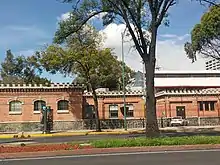Escuela Libre de Derecho
Escuela Libre de Derecho (ELD) is a law school in Mexico City founded in 1912.
 | |
Other name | ELD |
|---|---|
| Motto | "Jus neque inflecti gratia, Neque perfringi potentia, Neque adulterari pecunia debet" (Latin) |
Motto in English | "Law cannot be influenced by favor, seduced by power nor adulterated by pecuniary favor" |
| Type | Private |
| Established | July 24, 1912 |
| Affiliation | Illustrious and National Bar Association of Mexico |
| Rector | Emilio González de Castilla del Valle |
| Students | 640 |
| Address | Dr. José María Vértiz 12, Colonia Doctores, Delegación Cuauhtémoc , , 19.425556°N 99.146111°W |
| Campus | Large City |
| Colors | Wine and gold |
| Website | https://www.eld.edu.mx/ |
Since its establishment in 1912, the Escuela has had as its only mission the teaching of law, breeding from the principles of academic freedom, outside of any form of religiosity, or political ideology. Alumni of this school practice law in the private, as well as in the public sector, in every level of government, in the three branches of government and constitutionally autonomous organisms, and includes among its alumni two Mexican presidents, and ten Supreme Court ministers.
History

Escuela Libre de Derecho was founded on July 24, 1912, by several alumni of the Escuela Nacional de Jurisprudencia in protest of the imposition of Luis Cabrera as the dean, overlooking Don Jorge Vera Estañol.
Today, it is considered one of the most prestigious law schools in Mexico.[1]
Characteristics of the School
Some of the fundamental characteristics of the school is that it is sponsored by the board of the Illustrious and National Bar Association of Mexico (Ilustre y Nacional Colegio de Abogados de México, in Spanish), and, in accordance with the "Regulatory Decree of Free Schools" (Decreto Regulatorio de Escuelas Libres, in Spanish) of October 22, 1929, on its first article it defines free schools as the teaching institutions sustained by private efforts and resources, that have for purpose to provide artistic, middle school, high school, or professional education; and on article 7 establishes that the concession granted by the then acting president, Emilio Portés Gil constituted the legal title of the authorized free school, giving the school a definitive right which cannot be canceled, having plain right to issue its diplomas according to its study plans, without the need of the recognition of the official validity of studies granted by the Public Education Secretary. Being the Escuela Libre de Derecho the only one in its type subject to said privilege regime.
Another characteristic of this school is that its teachers do not receive a salary or monetary compensation whatsoever, which is why students only make a symbolic payment used to cover the school expenses.
Motto and Principles of Escuela Libre de Derecho
The motto for Escuela Libre de Derecho is "Ius neque inflecti gratia, Neque perfringi potentia, Neque adulterari pecunia debet", which traduced from Latin means "law cannot be influenced by favor, seduced by power nor adulterated by pecuniary favor".
The building of Escuela Libre de Derecho counts with an access from the street Doctor José María Vértiz and another one from Arcos de Belén Avenue, said access has a hall with red walls that has transcribed in golden letters the article 6 of the schools regulation that states: "the order and discipline of the School are entrusted to the honor of its students and its teachers", emphasizing that the responsibility of the order inside and outside of the Institution rests in its student body and teachers, who always have in consideration that in Escuela Libre de Derecho everyone act in good faith.
Evaluation and Certification
Escuela Libre de Derecho is the only professional teaching institution in the country where courses last a full year and it counts with an evaluation system consisting in a unique final exam for every course, consisting in verbal replies presented upon a jury integrated by, at least, three sinodles who shall be able to practice law by having a lawyer degree. This system is based in having a maximum number of courses a student can fail each year, as long it does not exceeds five courses, failing a sixth course would be cause for definitive discharge from the Institution; the ordinary time to conclude studies in this Institution and according with its study plan is of five years, but it cannot be extended by more than two years, since it would cause definitive discharge of the student.
The grades assigned by the examining jury in each course are unappealable. Once all the courses required by the Institution are approved, the student shall present a grade exam in which a thesis is presented and a practical case solved, in case the examining jury considers the student is apt to approve this exam, the School, under the patronage of the Illustrious and National Bar Association of México will issue the corresponding diploma for the law studies in order to practice law, different from the rest of teaching institutions in Mexico that issue their degrees for bachelor of law; obtaining the alumni form Escuela Libre de Derecho by the Public Education Secretary a lawyer certification.
Felipe Tena Ramírez Library
Escuela Libre de Derecho has the second most important specialized law library in the country. It was originally founded with the school and has a reserved fund and various collections with over 60,000 volumes.[2] The library was located on the second floor of the institution, until its own building was adapted in the old nearby factory, with which its collection could be increased. The newspaper library and the general collections are cataloged and classified. The theses and state legislation collections are being automated. In 2016 it was given the name Felipe Tena Ramírez.
Notable alumni
Mexican Presidents
- Emilio Portes Gil, 41st President of Mexico (1928-1930)
- Felipe Calderón, 56th President of Mexico (2006-2012)
Cabinet secretaries
- Carlos María Abascal Carranza, Secretary of the Interior (2005-2006)
- Fernando Gómez-Mont, Secretary of the Interior (2008-2011)
- Javier Lozano Alarcón, Secretary of Labor (2006-2011)
Other
- Carlos Reygadas, filmmaker
- Margarita Zavala, Mexican politician and former first lady (2006-2011)
Famous faculty
- Pedro Lascuráin, former president of Mexico.
- Miguel Mancera, former governor of the Banco de México.
- Manuel Borja Soriano
- Felipe Tena Ramírez
- Ramón Sánchez Medal
- Demetrio Sodi Guergué
- Carlos Sodi Serret
- José Luis de la Peza
- Manuel Herrera y Lasso
- Carlos Müggenburg y Rodríguez-Vigil
- Diego Martín del Campo y Souza
- Fauzi Hamdan Amad
- Arturo Zaldívar Lelo de Larrea
- Javier Lozano Alarcón
- Mauricio Oropeza Segura
- Luis Pazos
- Loretta Ortíz Ahlf
- Luis Ruiz Rueda
- Luis Ruiz Quiroz
See also
References
- "New Mexican Class Action Law | Events | Foley & Lardner LLP". www.foley.com. Retrieved 2022-09-04.
- "Biblioteca Felipe Tena Ramirez". Secretaría de Cultura/Sistema de Información Cultural (in Spanish). Retrieved 2022-08-30.